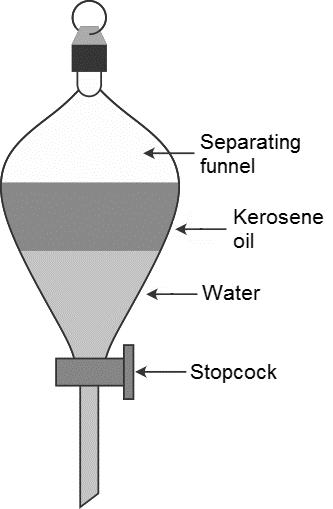
Name the method you shall use to separate two immiscible liquids.
Answer
578.4k+ views
Hint: “Immiscible liquids are those which won't mix to give a single phase. Oil and water are examples of immiscible liquids. One floats on top of the other”.
Complete step by step answer:
We know that the property of immiscibility is going to depend on the polarity of the liquids.
-If two liquids are polar in nature they will miscible in one another very easily.
-If two liquids are non-polar then also they will miscible very easily.
-If one liquid is polar and the other liquid is non-polar they won’t miscible very easily and then they are called immiscible liquids.
-But it is not that much easy to separate the two immiscible liquids.
-There is a separate technique to separate those immiscible liquids.
The name of the instrument which is used to separate two immiscible liquids is called as separating funnel.

-By using the separating funnel we can easily separate two immiscible liquids.
-We have to take the two immiscible liquids into the separating funnel and close the separating funnel with a knob and leave it for a few minutes till the two layers separated.
-In the picture itself it shows that the kerosene and water are two immiscible liquids separated.
-The kerosene floats on the surface of water.
-After separation of two immiscible layers remove the knob and collect the layers separately by using a stopcock..
-First by using the stopcock we can collect the water and then kerosene in two separate beakers.
Note:
Don’t be confused with the words polar and non-polar.
Polar means the chemicals which are soluble in water are called polar.
Non-polar means the chemicals which are not soluble in water are called as non-polar.
Complete step by step answer:
We know that the property of immiscibility is going to depend on the polarity of the liquids.
-If two liquids are polar in nature they will miscible in one another very easily.
-If two liquids are non-polar then also they will miscible very easily.
-If one liquid is polar and the other liquid is non-polar they won’t miscible very easily and then they are called immiscible liquids.
-But it is not that much easy to separate the two immiscible liquids.
-There is a separate technique to separate those immiscible liquids.
The name of the instrument which is used to separate two immiscible liquids is called as separating funnel.

-By using the separating funnel we can easily separate two immiscible liquids.
-We have to take the two immiscible liquids into the separating funnel and close the separating funnel with a knob and leave it for a few minutes till the two layers separated.
-In the picture itself it shows that the kerosene and water are two immiscible liquids separated.
-The kerosene floats on the surface of water.
-After separation of two immiscible layers remove the knob and collect the layers separately by using a stopcock..
-First by using the stopcock we can collect the water and then kerosene in two separate beakers.
Note:
Don’t be confused with the words polar and non-polar.
Polar means the chemicals which are soluble in water are called polar.
Non-polar means the chemicals which are not soluble in water are called as non-polar.
Recently Updated Pages
Why are manures considered better than fertilizers class 11 biology CBSE

Find the coordinates of the midpoint of the line segment class 11 maths CBSE

Distinguish between static friction limiting friction class 11 physics CBSE

The Chairman of the constituent Assembly was A Jawaharlal class 11 social science CBSE

The first National Commission on Labour NCL submitted class 11 social science CBSE

Number of all subshell of n + l 7 is A 4 B 5 C 6 D class 11 chemistry CBSE

Trending doubts
What is meant by exothermic and endothermic reactions class 11 chemistry CBSE

1 Quintal is equal to a 110 kg b 10 kg c 100kg d 1000 class 11 physics CBSE

What are Quantum numbers Explain the quantum number class 11 chemistry CBSE

What is periodicity class 11 chemistry CBSE

What is a periderm How does periderm formation take class 11 biology CBSE

Mention the basic forces in nature class 11 physics CBSE




